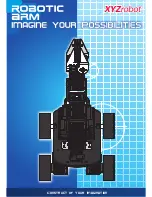
Warning:
When powering the Arduino from the Zumo Shield, you must never connect a different
power supply to the Arduino’s VIN pin or plug a power supply into the Arduino’s power jack, as doing
so will create a short between the shield’s power supply and the Arduino’s power supply that could
permanently damage both the Arduino and the Zumo Shield.
When the Arduino is connected to a computer via USB, it will receive power (and supply 5V and
3.3V to the shield) even when the Zumo Shield’s power switch is off. This can be useful if you
want to test your Arduino program without allowing the motors to run, since turning the power
switch off disconnects motor power (VBAT).
LEDs
There are five LEDs on the Zumo Shield:
• A set of power LEDs, one
blue
and one
red
, is located in each of the two rear corners of the shield.
• A
yellow
user LED is located on the right edge of the shield. It is connected to
digital pin 13
on the
Arduino, in parallel with the Arduino’s onboard user LED.
Pushbuttons
Two pushbuttons can be soldered to the Zumo Shield:
• The
reset pushbutton
is located on the left edge of the shield. It is connected to the Arduino’s RESET
pin and can be pressed to reset the Arduino.
• The
user pushbutton
is located on the rear edge of the shield. It is connected to
digital pin 12
on the
Arduino; pressing the button pulls the pin low. The Pushbutton library, included with our
[http://www.pololu.com/docs/0J57/6]
, makes it easy to detect and debounce button presses with this
pushbutton.
Motor driver
An integrated
[http://www.pololu.com/catalog/product/2135]
dual motor driver on the Zumo Shield drives the
Zumo’s two micro metal gearmotors. Four Arduino pins are used to control the driver:
•
Digital pin 7
controls the
right motor direction
(LOW drives the motor forward, HIGH drives it in
reverse).
•
Digital pin 8
controls the
left motor direction
.
•
Digital pin 9
controls the
right motor speed
with PWM (pulse width modulation).
•
Digital pin 10
controls the
left motor speed
with PWM.
The
[http://www.pololu.com/docs/0J57/6]
provides functions that allow you to easily control the
motors, and it can optionally take care of flipping a direction signal for you if you accidentally soldered in a motor
backwards.
Buzzer
The Zumo Shield comes with a buzzer that can be used to generate simple sounds and music (for example, you
could use it to produce an audible countdown at the beginning of a sumo match). The buzzer control line is labeled
Pololu Zumo Shield for Arduino User's Guide
© 2001–2012 Pololu Corporation
3. The Zumo Shield in detail
Page 17 of 28












































